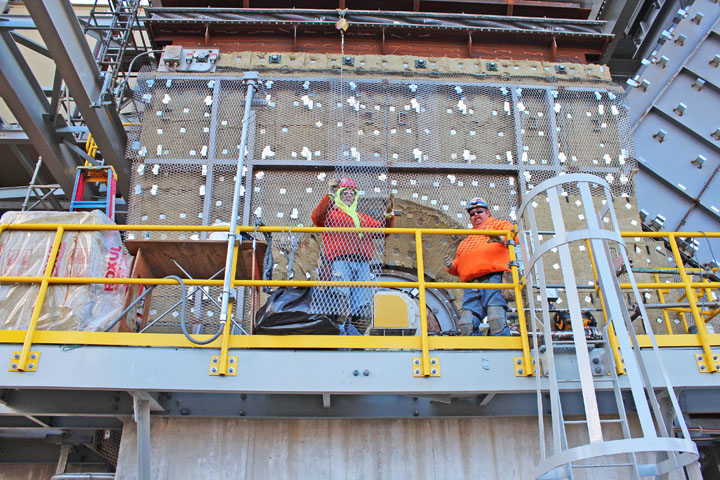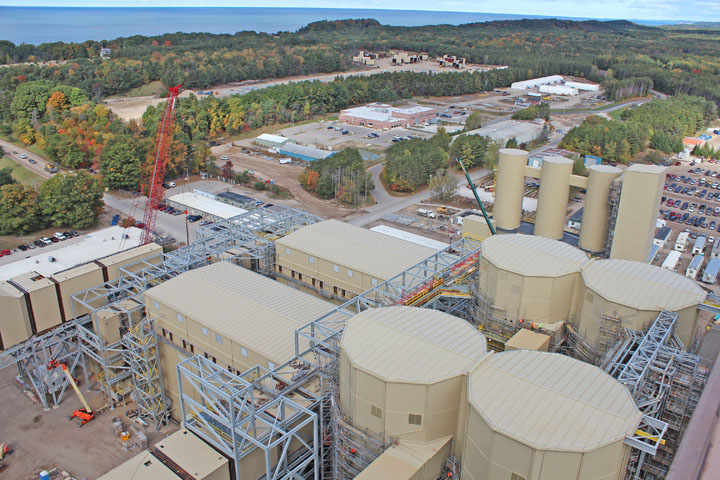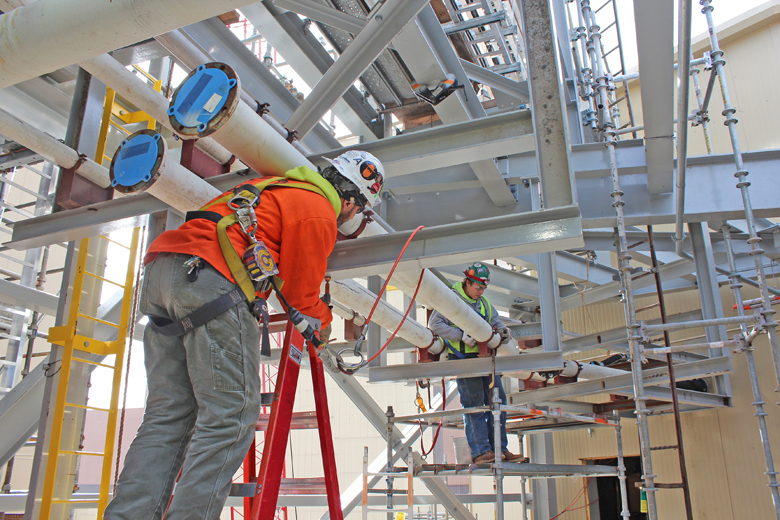Trades help clean the air at Consumers Campbell plant
Date Posted: November 27 2015

WEST OLIVE - While natural gas, solar and wind energy are increasingly important parts of Michigan's energy production portfolio, the heat provided by burning coal is still creating about 50 percent of the state's energy.
And one of the largest coal-burning power plants in the state is Consumers Energy's J.H. Campbell Generating Facility, a three-unit, 1,450-megawatt plant located about 20 miles north of Holland near the Lake Michigan shore. The plant has been in operation since the 1960s, and major improvements, expansions and modifications over the years have just about doubled the size of the facility's footprint.
About $1 billion worth of modifications at the plant have been ongoing since 2009, and in recent months about 800 tradespeople have been steadily employed there, mostly concentrating on modifying Units 1 and 3 to bring them in compliance with federal air quality standards.
"The great majority of the work has gone very well," said Consumers Energy Construction Manager Marty Malek. "In the big picture, we're making progress every day. When we have gotten off target as a team, our unions and contractors and the owner have worked hard to communicate how we can improve to make the project better."
The Campbell Generating Complex consists of three separate coal-fired units: the 260-megawatt Unit 1 (online in 1962), 355-megawatt Unit 2 (1967) and the 835-megawatt Unit 3 plant (1980), which includes the largest coal-fueled boiler in the utility's fleet. The three are considered baseload units because they generally operate 24 hours a day, 365 days a year. The plant has the capacity to serve the electrical needs of about 1 million customers.
Federal clean air requirements have necessitated the replacement of old pollution-controlling electrostatic precipitators with next-generation equipment at Campbell, and the upgrades at the plant's three units are at various stages.
Campbell Unit 1 controls nitrogen oxide emissions with a low-NOx burner system already installed by the building trades, and Units 2 and 3 employ selective catalytic reduction systems for that purpose.
Pulse jet fabric filters to control particulate matter are already in place on Unit 2, and are being installed on Units 1 and 3. All three units are getting activated carbon injection systems installed to control mercury emissions as part of this project, and all three are also getting either dry sorbent injection systems or spray dry absorbers to control acid gases.
"We take our air quality commitment very seriously," said Consumers Energy spokesman Roger Morgenstern. "Cleaner air is a government mandate, and our customers want it, so it has been a continuous investment for us over the years at our plants. We're also heavily involved in renewable energy production, and it's all part of an effort to make our fossil fuel plants cleaner, as well as make Michigan a more diverse state in terms of energy production."
The ongoing work at the Campbell plant offers a familiar challenge for construction staffers at Consumers Energy, as well as their contractors and with the trades: the plants simply weren't built with emission control modifications in mind. All of the above systems need to be designed and shoe-horned into tight places that were never intended to receive them - and the original plans for underground pipes, power and foundation locations are sketchy at best.
"For example, all the new foundations are in place," Malek said, "but we had to use every bit of technology out there (including ground-penetrating radar) to make sure we didn't run into anything when we were drilling or excavating. I'm sure we still didn't find everything. We had to soft dig everywhere, and it was a very tedious process."
Morgenstern said the utility also has to perform its present modifications with the future in mind: "There are more milestones for carbon reduction due in 2020," he said, "and we're going to have to do even more work. We're just not sure yet what that's going to be." He said Consumers Energy leaders are constantly researching options to make sure that current emission control systems don't become obsolete any time soon, and can be modified as easily as possible in the future.
Malek said the current phase of work is at about 1.2 million man-hours worked, on the way to about three million man-hours worked upon completion. He said the current 1.39 recordable injury incident rate per 200,000 man-hours worked is "not where we want to be," since their goal is always 0 and their target is set to always be below 1.0. Consumers is continually stressing to its contractors that worker safety is the most important aspect of the project.
"Safety is first and foremost," Malek said. "We want everyone working to go home safely, with the plant running well. The things we tell our people is that we will work safely and do the job once with quality."
Boldt is acting as general contractor on the project, and other major mechanical players include Northern Boiler, Great Lakes Mechanical, Wolverine Fire Protection, Conti Electric and Newkirk Electric.
Malek said the biggest challenge of the entire project is expected to be a planned 84-day plant outage that starts March 5, with 55 working days and nine Sundays to be used as needed. The remaining time is to come off line and then ramping up to get back on line which includes start up, testing, and commissioning operations. On Unit 3, he said the trades will need to work seven days, sometimes around the clock, to demolish an existing "massive" electrostatic precipitator in 18 days, then set structural steel and new duct work for the new work.
"The tradespeople out here have been fantastic to work with," Malek said. "Nationally, we're working through a labor shortage, but the local unions have done everything they can to bring in people to do the work, and together with the contractors, they have really brought Consumers Energy some good people."
Mark Mangione, president of the West Michigan Building and Construction Trades Council and business manager of Plumbers, Pipe Fitters and Service Trades Local 174, said labor-contractor-owner cooperation is becoming vital to promote safety, quality and on-time performance, especially on major construction projects.
"The tripartite concept has caught on in Michigan and it's catching on across the country, because it really works to improve the construction industry," Mangione said. "It requires teamwork, communication, and people committed to make it happen. Consumers Energy has always shown that they're at the forefront of tripartite agreements with their contractors and the trades, and it's working well here."

HERE’S A BIRD’S EYE view of new emission control work at the Consumers Energy Campbell Plant Unit 3 in West Olive, near Lake Michigan. Most prominent in the foreground are two new baghouse structures, four new cylindrical spray dryer-absorbers, and three lime prep structures.

SETTING UP MESH in the process of insulating an ID fan at the J.H. Campbell Plant are Eric Steinke and Chris Jarman of Heat and Frost Insulators Local 47. They’re employed by Great Lakes Mechanical.

HEFTING A 4-INCH conduit section at the Campbell plant are Jonathan Hallberg and Al Buckner of IBEW Local 275. They’re employed by Conti Electric.
